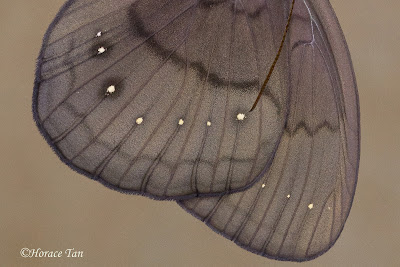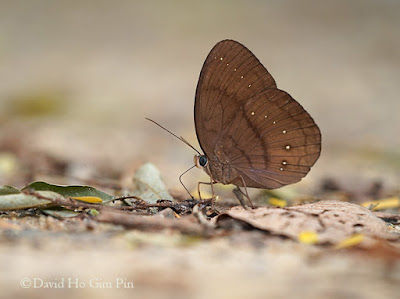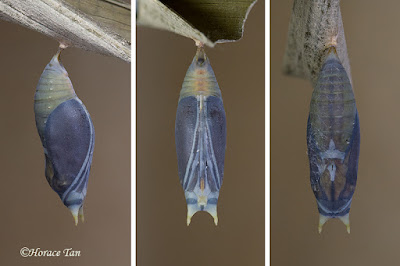Butterfly Biodata:
Genus: Faunis Hübner, 1819
Species: canens Hübner, 1826
Subspecies: arcesilas Stichel, 1933
Wingspan of Adult Butterfly: 55-65mm
Caterpillar Local Host Plants: Caryota mitis (Palmae, common name: Fish Tail Palm), Plectocomia elongata (Palmae, common name: Giant Rattan Palm), Molineria latifolia (Hypoxidaceae, common name: Weevil Lily), Cyrtostachys lakka (Palmae, common name: Lipstick Palm).
Physical Description of Adult Butterfly:
On the upperside, the wings are orange-brown and unmarked. On the underside, the wings are deep brown. On both fore- and hindwings, there are basal, discal and submarginal series of dark brown lines transvering the wings, as well as a series of post-discal whitish spots.
Close-up view of the deep-bluish eyes of the Common Faun.
Close-up view of the wings of the Common Faun.
Field Observations of Butterfly Behaviour:
The Common Faun is relatively common in Singapore and is usually found flying close to ground in the shady understorey of forested areas within the nature reserves. Typically, it is found in the company of other species of Nymphalidae (such as the Saturn, Archduke and the Dark-Blue Jungle Glory) feeding on fallen fruits on the forest floor. With its deep brown coloration, the Common Faun is well-camouflaged among the leaf litter on the forest floor.
Early Stages:
Caterpillars of the Common Faun are polyphagous, and they utilize a number of plants as larval food plants. Most of these plants are in the Palmae family. One of the most commonly used plant is Caryota mities (Fish-Tailed Palm).
On the upperside, the wings are orange-brown and unmarked. On the underside, the wings are deep brown. On both fore- and hindwings, there are basal, discal and submarginal series of dark brown lines transvering the wings, as well as a series of post-discal whitish spots.
Close-up view of the deep-bluish eyes of the Common Faun.
Close-up view of the wings of the Common Faun.
Field Observations of Butterfly Behaviour:
The Common Faun is relatively common in Singapore and is usually found flying close to ground in the shady understorey of forested areas within the nature reserves. Typically, it is found in the company of other species of Nymphalidae (such as the Saturn, Archduke and the Dark-Blue Jungle Glory) feeding on fallen fruits on the forest floor. With its deep brown coloration, the Common Faun is well-camouflaged among the leaf litter on the forest floor.
Early Stages:
Caterpillars of the Common Faun are polyphagous, and they utilize a number of plants as larval food plants. Most of these plants are in the Palmae family. One of the most commonly used plant is Caryota mities (Fish-Tailed Palm).
Local host plant #1: Caryota mitis (Fish Tail Palm).
Local host plant #2: Plectocomia elongata (Giant Rattan Palm).
A mating pair of the Common Faun.
A mother Common Faun ovispositing on the leaf underside of the Fish-Tailed Palm.
A mother Common Faun ovispositing on the leaf underside of an unidentified plant.
Eggs of the Common Faun are laid in a small group of 5 to 10 eggs, typically on the underside of a leaf of the host plant. The pale whitish egg is spherical in shape and appear to have a smooth surface. A close-up view of the egg shows that the surface is covered with numerous, small and faint polygonal markings. Each egg has a height or diameter of about 1.5 mm.
Top view of a group of seven eggs of the Common Faun.
Lateral view of the same group of seven eggs of the Common Faun.
Left: lateral view; Right: top view of an egg of the Common Faun. Diameter: 1.5mm.
Developing eggs of the Common Faun, day 5 after oviposition.
Two views of a mature egg of the Common Faun.
The egg takes about 8 days to hatch. The young caterpillar emerges by eating a sufficiently large part of the egg shell. The newly hatched is about 4mm in length and it has a cylindrical and whitish to pale brown body covered with rows of long black setae (hair) dorsally and dorso-laterally, and white setae laterally. The head capsule is dark brown. After emergence, the newly hatched proceeds to devour the rest of the egg shell.
Two views of a newly hatched Common Faun caterpillar soon after its emergence.
A group of three newly hatched Common Faun caterpillars, with two more yet to hatch.
The 1st instar caterpillars feed together on the leaf lamina at the leaf edge. As the caterpillar feeds and grows, the body takes on a green undertone. In the last two days of the 1st intar, the first few and the last few body segments take on a brown coloration. After reaching about 8-9mm in about 6 days, the caterpillar moults to the 2nd instar.
Two views of a 1st instar caterpillar, length: 6.2mm.
A group of 1st instar Common Faun caterpillars.
Two views of 1st instar caterpillar, late in this stage, length: 8.8mm.
The body of the 2nd instar caterpillar is black on the 3 last segments and initially brownish but turning greyish on the remaining segments. Each of these segments is adorned with a black spot on the dorsum. Long setae cover all body segments. These setae is a mixture of shorter black setae and much longer white setae. There is also a pair of short, white and pointed anal processes. The head capsule is orange-colored in most specimens but can be black-colored in odd specimens. The head capsule bears two cephalic horns, the tip of which has a few short spines emanating from it. This instar lasts about 4 days with the body length reaching about 14.5mm.
Two views of a 2nd instar caterpillar of the Common Faun, early in this stage, length: 8mm.
Front view of the "face" of a 2nd instar caterpillar which has "black" face as opposed to the more common orangy brown face.
Two views of a 2nd instar caterpillar of the Common Faun, length: 11mm.
A group of 2nd instar Common Faun caterpillears resting together at the feeding site.
The 3rd instar caterpillar resembles the 2nd instar caterpillar but without the black spots on the dorsum. The whitish long setae on all body segments are longer proportionately compared to those in the second instar. Narrow white bands running lengthwise on the dorsumm are now discernible. There is also a series of wavy white bands occurring spiracularly. The first two and last two body segments are much darker than the other body segments. This instar takes about 4 days to complete with body length reaching about 20mm.
Two views of 3rd instar caterpillars of the Common Faun, length: 20mm.
A group of 3rd instar Common Faun caterpillears resting together at the feeding site.
Frontal view of the heads of several 3rd instar Common Faun caterpillars.
Close-up frontal view of the head of a 3rd instar Common Faun caterpillar.
The 4th instar caterpillar closely resembles the 3rd instar caterpillar, but with much denser coat of whitish setae all over the body. Most specimens have their head capsule taken on dark brown to black patches. The 4th instar lasts about 5-6 days with the body length reaching about 29mm.
Two views of a 4th instar caterpillar, length: 25mm.
Frontal view of the heads of three 4th instar Common Faun caterpillars.
A group of nice 4th instar Common Faun caterpillars resting on a palm leaf.
A group of 4th instar Common Faun caterpillar found in the field on a leaf of an unknown dicot plant.
Compared to the 4th instar caterpillar, the 5th (and final) instar caterpillar has additional orangy brown setae which are shorter than the long white setae. These brown setae are much denser in the anterior body segments. The head now features distinctive black markings with large lateral patches above an inverted V-shaped transverse band.
Two view of a 5th instar Common Faun caterpillar, length: 41mm.
A group of nine 5th instar Common Faun caterpillars on a palm leaf.
Front view of a group of 5th instar Common Faun caterpillars, showing their ``faces''.
Close-up frontal and side views of the head of a 5th instar Common Faun caterpillar.
The 5th instar lasts for 8 to 10 days, and the body length reaches up to 44-45mm. On the last day, the body becomes shortened and the caterpillar ceases feeding and wanders around. Eventually it stops at a spot on the underside of a leaf or a stem and spins a silk pad from which it hangs vertically to take on the pre-pupatory pose.
A pre-pupa of the Common Faun.
The pupation event of a Common Faun caterpillar.
Pupation takes place about one day later. The pupa suspends itself from the silk pad with no supporting silk girdle. The pupal body is yellowish green in colour with no marking. The dorsum of the thoracic segments are raised slightly at the mesothorax. At the anterior end, there are two short cephalic horns with yellowish pointed tips. Length of the pupa: 24.5-26mm.
Three views of a pupa of the Common Faun, brown form.
A group of four Common Faun pupae on the underside of a palm leaf.
After about 8-9 days of development, the pupa darkens in colour with the wing pads turning brownish. The next morning, the mature pupa becomes mostly deep dark brown and the adult Common Faun emerges soon after.
Three views of a mature pupa of the Common Faun.
The eclosion event of a Common Faun butterfly.
A newly eclosed Common Faun resting on its pupal case.
References:
- [C&P5] The Butterflies of The Malay Peninsula, A.S. Corbet and H.M. Pendlebury; G. and N. van der Poorten (Eds.), 5th Edition, Malayan Nature Society (2020).
- Butterflies of Thailand, Pisuth Ek-Amnuay, 2nd Edition, 2012.
Text by Horace Tan, Photos by David Ho Gim Pin, Lim Cheng Ai, Koh Cher Hern, Bobby Mun, Tan Ben Jin, Frederick Ho, Khew S K and Horace Tan, Videos by Horace Tan.















































